Web3 is drastically reshaping how people interact with the digital world. It’s not just a new layer of technology — it’s a fundamental shift in ownership, trust, and design principles. Built on blockchain technology, NFTs, decentralized applications, and cryptocurrency, Web3 represents what many see as the next big leap in the evolution of the internet. Perhaps the most defining feature of Web3 is decentralization — the movement away from central authority and toward transparent, secure, and user-owned systems.
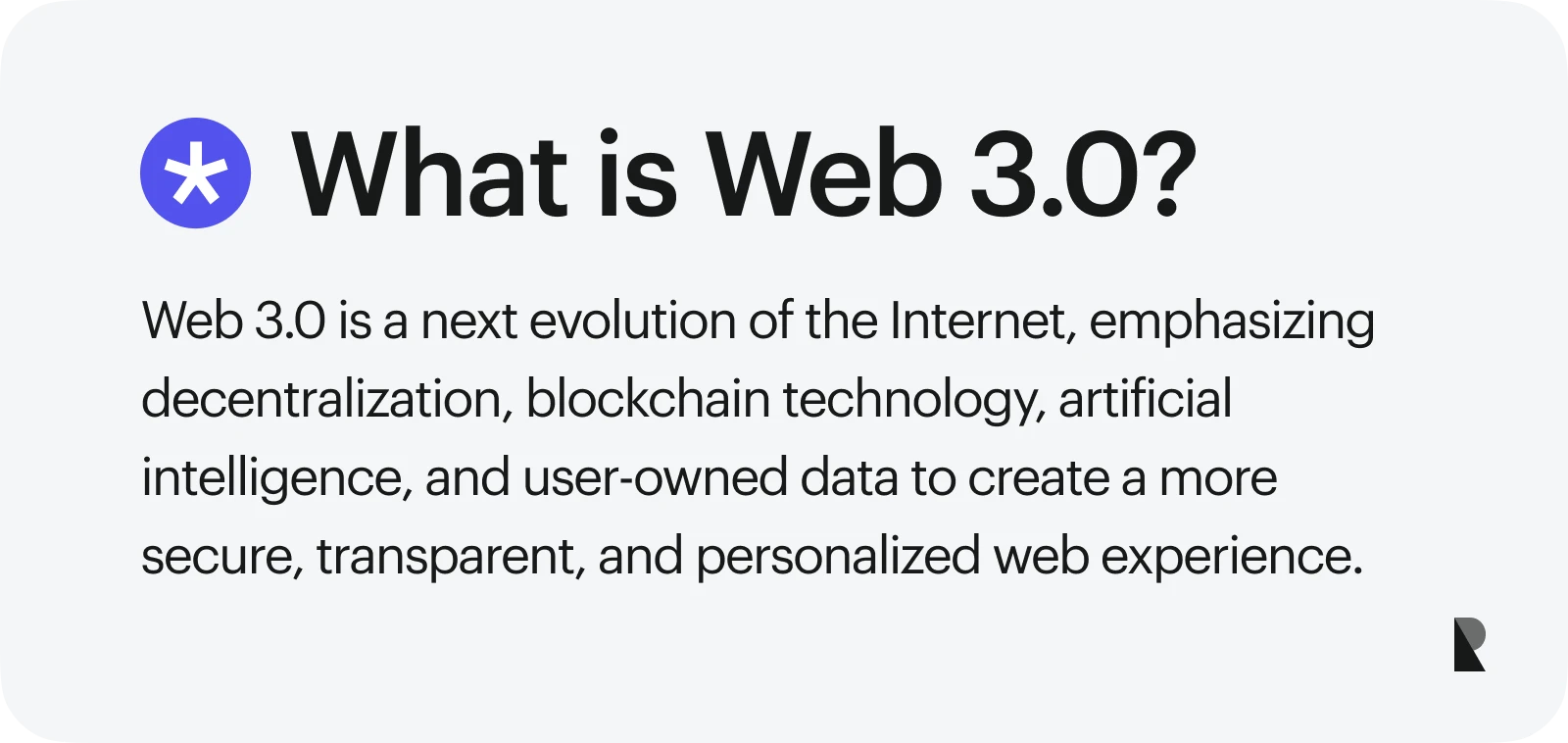
This evolution isn't just a matter of aesthetics for product designers, developers, and UI/UX professionals. It changes the entire relationship between the product and its audience. Designing for Web3 means creating experiences that feel easy to understand while operating on inherently complex technology. Within this space, user experience acts as a bridge between abstract blockchain mechanics and the expectations of a mainstream user.

To make this even more straightforward, let’s highlight the crucial role of UX design in making decentralized products more functional, intuitive, human-friendly, and ready for mainstream adoption. We’ll explore how Web3 changes digital design rules, what challenges it introduces, and how the best designers are solving them.
Web1 vs. Web2: The Internet’s Evolution
To understand the importance of UI/UX design for Web 3.0, it helps to look briefly at how the internet has evolved up until now. Web1, in the early 1990s, was essentially static. Websites acted as digital brochures, delivering information in one direction with little interaction. Design was minimal, and user experience wasn’t even a recognized discipline.
Web2 changed everything. The early 2000s brought social networks, interactive platforms, and content creation tools that allowed users to contribute, collaborate, and share. With companies like Facebook, Google, and Amazon dominating, Web2 became a centralized ecosystem driven by user-generated content and data monetization. UI and UX design flourished, introducing mobile-first design, real-time interactions, and personalization at scale.
These changes didn’t just shape how websites looked — they defined how people expected to interact with digital products. By the mid-2010s, users expected apps to be more personalized, responsive, and available across various devices. Trust was often built through branding, customer support, and consistent patterns. Now, with Web3 on the rise, we’re facing another shift that is just as profound — one that removes the central authorities that shaped much of Web2’s design playbook and replaces them with distributed, peer-to-peer ecosystems.
What Is Web3?
Web3 is often described as a blockchain-based, decentralized, user-owned internet. Unlike Web2, where data is stored on centralized servers, Web3 runs on decentralized networks that distribute information across many nodes—public ledgers record transactions, creating transparency and immutability.
The decentralized economy allows for peer-to-peer transactions without intermediaries, enabling users to own their identities, control their data, and participate in governance. This shift also impacts brand identity — companies now have to design experiences where the brand lives within the product ecosystem, not on top of it. In Web2, the brand could sit as a polished layer between the user and the infrastructure; in Web3, the infrastructure is part of the brand experience.
And still, adoption is in its early stages. Nearly 70% of more than 50,000 survey respondents admitted they don’t know what Web3 is. This awareness gap means that Web3 design must bridge a significant learning curve, making complex concepts approachable for new users. That’s why onboarding, terminology, and visual clarity aren’t nice-to-have elements — they’re the critical levers that decide whether a Web3 product can move beyond its early adopters.
Why Web3 Products Need Great UI/UX
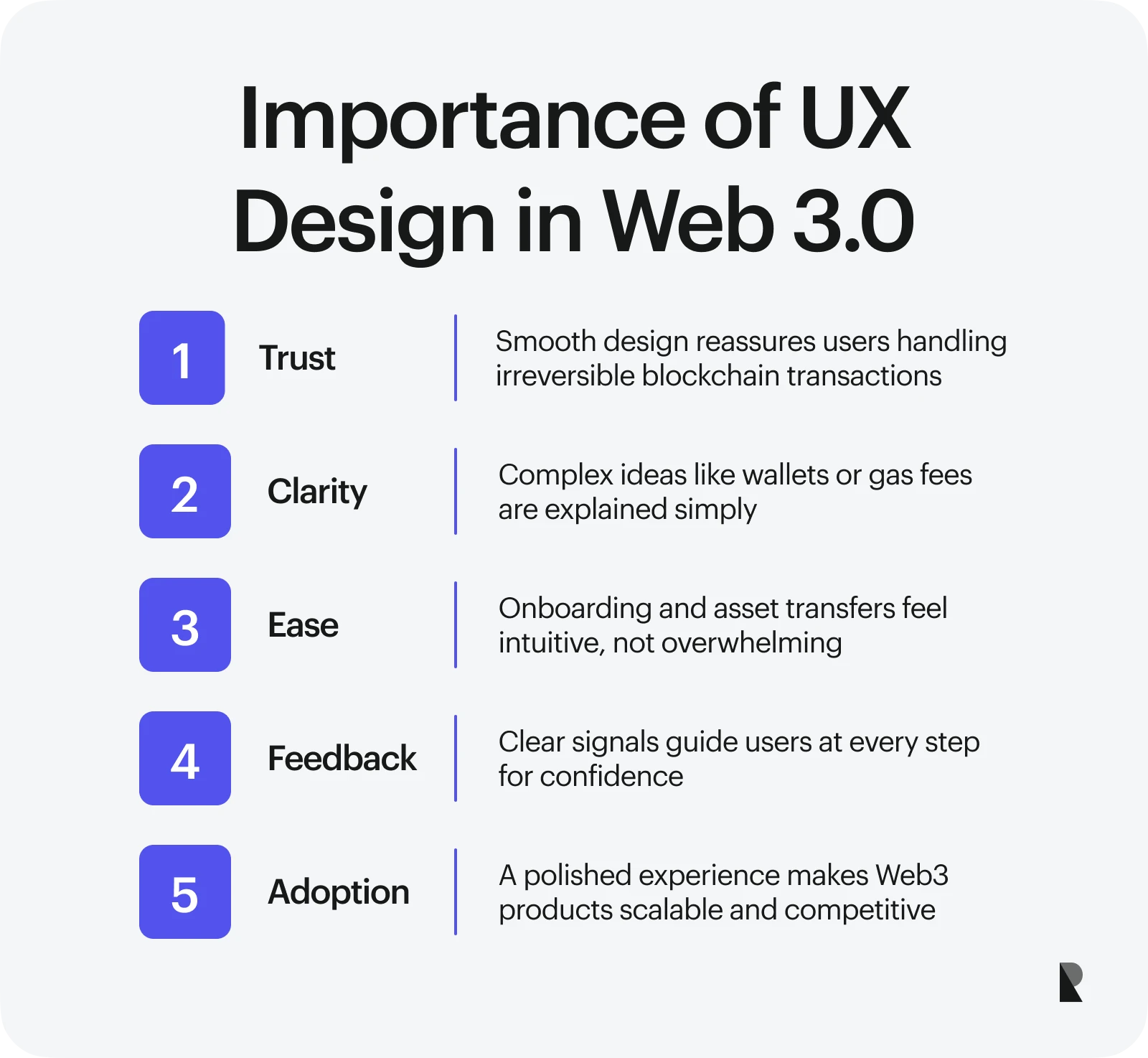
Like any other platform, a Web3 product can have groundbreaking technology and still fail if its interface confuses or frustrates people. Many Web3 products struggle because their onboarding is unclear, wallet interactions are overwhelming, or security warnings feel borderline intimidating. Poor UX design can be a turnoff even for tech-savvy users, and in a competitive decentralized economy, first impressions are critical.
Great UX design in Web3 builds trust. It makes a crypto wallet setup feel secure without being stressful. It explains gas fees without drowning the users in jargon. It guides new customers through transferring assets in ways that feel as natural as sending an email. It also provides visual feedback at every step so that people always know where they are, which is significant when blockchain transactions are irreversible.
More importantly, good design shapes how users feel about a product. As big tech companies watch and many Web3 startups vie for the same audience, a product’s UX can become the deciding factor in whether it scales or fades. The proper UX doesn’t just make the technology work — it makes the technology worth using.
4 Ways Web3 Changes Traditional UI/UX
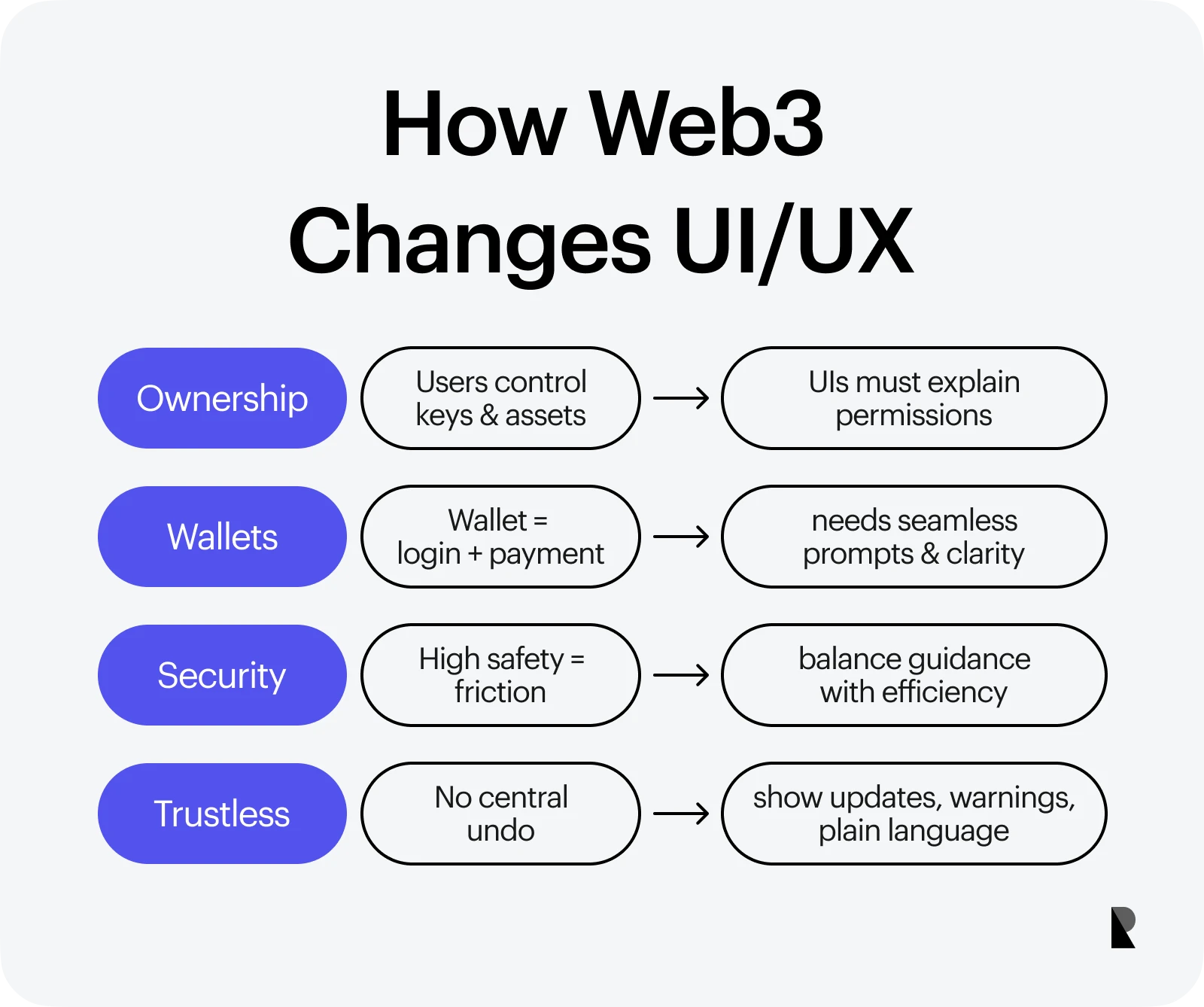
Web3 products present an entirely new set of design challenges. Interfaces must now be able to handle decentralized networks, immutable transactions, and wallet-based identities while remaining user—friendly.
1. Decentralization and user ownership
In Web2, accounts are hosted by centralized services. In Web3, users control their keys, data, and digital assets. This shift requires UI patterns that clearly explain ownership and permissions without overwhelming people. For example, decentralized applications often ask users to sign smart contracts before completing actions. Clear, well-structured confirmation screens can prevent costly mistakes. Designers now need to consider the interface itself and the trust implications of every interaction — because in a decentralized environment, there is no customer service team to “undo” a bad transaction.
2. Wallets as the new identity layer
A crypto wallet is no longer just a place to store tokens — it’s a user’s passport to the decentralized web. From accessing Web3 apps to verifying identity in decentralized finance platforms, wallet addresses serve as login credentials, payment methods, and security layers. UI design must make wallet integration seamless while ensuring users understand what’s happening (atep). This includes clear prompts for wallet permissions, explanatory tooltips, and visual confirmation of actions like connecting, signing, or transferring assets.
3. Security vs usability in Web3
Security is non-negotiable in a trustless environment. But high security often means extra steps — and extra friction. Asking users to store seed phrases, confirm multiple wallet signatures, and navigate blockchain explorers can feel overwhelming. UX design has to balance these demands, offering guidance that minimizes risk while keeping flows efficient. This may involve layered security — allowing new users to get started with simplified methods, while still providing advanced controls for experienced users who might want maximum self-custody.
4. Trustless onboarding and interactions
In Web3, “trustless” means you don’t have to rely on a central authority to verify transactions. For UI design, this means showing real-time transaction updates, providing clear security warnings, and using plain language instead of technical jargon. When onboarding new users, transparency about what’s happening builds confidence — especially in an ecosystem where mistakes can’t be undone. Designers should think about a user's emotional state during critical moments, like sending their first transaction, and ensure the interface supports them with reassurance, not confusion.
The Main Web3 Use Cases Shaping UX
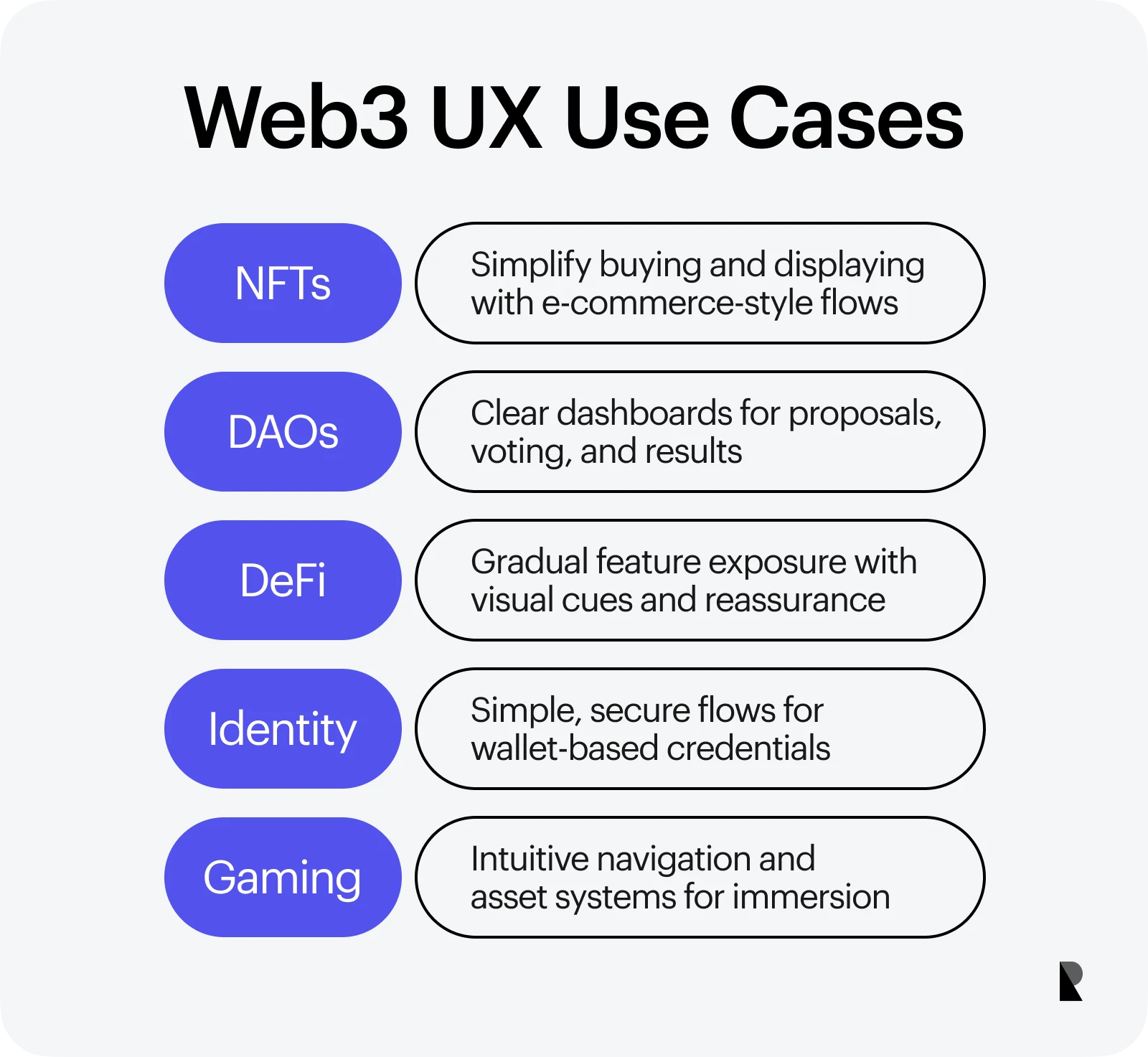
Web3 isn’t just one single product category. It’s an entire ecosystem of decentralized products, each with its UI/UX challenges.
NFT Platforms: UX priorities
NFT marketplaces must make buying, owning, and displaying NFTs easy to understand. This includes wallet connections, bidding flows, and visual galleries. Too many NFT platforms bury users in crypto terminology, creating unnecessary friction. Instead, the best NFT UX uses familiar e-commerce metaphors — clear product cards, price filters, and step-by-step purchase confirmations — while integrating blockchain-specific details like wallet addresses and transaction hashes in a digestible way.
DAOs: voting and dashboard UX
Decentralized Autonomous Organizations rely on clear governance interfaces. UX designers must prioritize intuitive dashboards that display proposals, voting mechanisms, and results without requiring members to dig through public ledgers. Accessibility is key here — members might be joining from different backgrounds and skill levels, so interfaces must balance sophistication with clarity.
DeFi: simplifying complex flows
Decentralized finance platforms are among the most intimidating Web3 products for new users. The learning curve is steep between gas fees, liquidity pools, and staking mechanics. Product designers need to use progressive disclosure to gradually introduce these features, making them less daunting while maintaining transparency. An effective DeFi UX reassures users at every step — from connecting a wallet to confirming a swap — with visual cues, status updates, and concise explanations.
Decentralized identity UX
Digital identity in Web3 is tied to wallets and verifiable credentials. UX design must make ID creation, verification, and recovery accessible while ensuring top privacy and security levels. Since identity flows often involve sensitive permissions, the interface must clearly explain the implications of each action — especially when granting access to personal data.
Web3 gaming and metaverse
From immersive worlds to peer-to-peer asset trading, Web3 gaming experiences depend on responsive, intuitive interfaces. Designing navigation, inventory systems, and customization tools that feel seamless is critical for user retention. In these environments, UI/UX design doesn’t just serve utility. It shapes the player's emotional connection with the game’s economy, identity system, and social spaces.
Unique Web3 UX Challenges
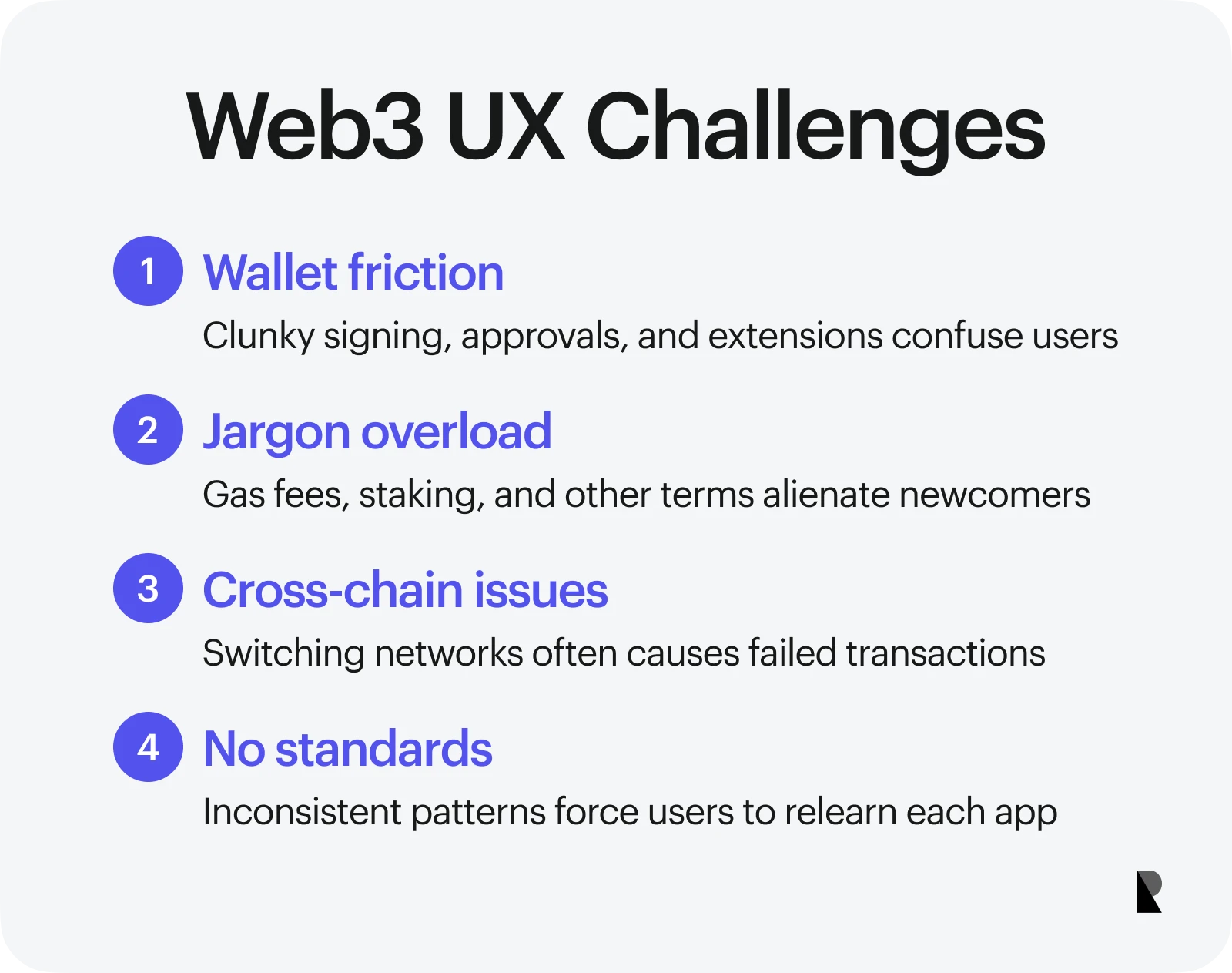
Even with innovation driving the decentralized economy forward, many Web3 products still face usability hurdles. These aren’t minor inconveniences — they’re barriers to adoption that can make or break a product’s success.
Complex wallet interactions
For many Web3 products, wallet interaction is the first point of friction. Signing multiple transactions, approving smart contracts, or navigating between browser extensions and mobile apps can feel clunky. If product designers fail to guide the user through these steps clearly, they risk losing them entirely.
Jargon and overload
Web3 has its language — gas fees, staking, liquidity pools, public ledgers, and blockchain explorers. While these terms are meaningful to seasoned users, they can intimidate or alienate new users. Creating an easy-to-understand user experience means translating technical terms into plain language, especially during onboarding.
Cross-chain confusion
Many Web3 products operate across multiple blockchains, and switching chains can cause errors or failed transactions. New users may not even realize why an action failed without clear instructions and visual cues.
No universal design patterns
Unlike Web2, where UI/UX conventions have matured over decades and we all agreed on what worked, many Web3 design patterns are still emerging. This leads to inconsistent navigation, unpredictable interaction models, and unfamiliar iconography. Without standardization, even experienced users must relearn interfaces for every Web3 app they try.
Best Practices for Web3 UI/UX Design
To overcome these challenges, Web3 designers must borrow the best of Web2 usability while adapting to the unique realities of decentralization. These principles also guide any business considering hiring a UI/UX design agency to develop their Web3 product.
| Onboarding non-crypto users | The vast majority of new users will have no prior experience with wallets, smart contracts, or decentralized applications. Onboarding flows should be visual, interactive, and broken into small, digestible steps. This is where a seasoned UI/UX design agency can add significant value — building onboarding systems that reduce the learning curve without oversimplifying the product. |
| Progressive disclosure | Web3 products often have advanced features that can overwhelm first-time visitors. Progressive disclosure (revealing complexity only as needed) helps keep the interface user friendly and reduces the cognitive load. |
| Leverage familiar visual patterns | While the back-end technology of Web3 is new, the front-end doesn’t have to feel alien. Borrowing familiar navigation structures and visual hierarchies from Web2 can help many Web3 products feel more approachable to their target audience. |
| Responsive microinteractions | In decentralized environments where actions like transferring assets or executing smart contracts can take several seconds, responsive microinteractions are vital. Animated loading indicators, status updates, and confirmation messages help users stay informed and reduce anxiety. |
| Mobile-first, wallet-centric design | With the growth of Web3 fintech and mobile-based crypto exchanges, mobile-first thinking is essential. Wallet integration must be seamless, with minimal disruption to task flows — especially in markets where mobile devices are the primary gateway to the decentralized network. |
UX in Different Web3 Verticals
The principles of Web3 UX design apply broadly, but their execution varies depending on the product’s focus and audience. Security and clarity are crucial for
For decentralized finance (DeFi) platrtant. Interfaces need to explain risks without overloading users with technical jargon. In NFT marketplaces, the emphasis is generally on visual presentation and frictionless purchasing flows. For Web3 fintech products and startups, regulatory compliance and reliability are just as crucial as sleek design.
Web3 gaming and metaverse experiences push UX into immersive environments, where navigation, customization, and peer-to-peer interaction drive engagement. In enterprise-focused blockchain applications, interfaces must blend Web3 capabilities with the stability and predictability expected from big tech tools.
Choosing the right design partner is critical across these verticals. Reviewing case studies from top UX design firms can help businesses see how leading agencies balance innovation with usability, delivering products that meet industry standards while pioneering new user experiences.
Conclusion
Web3 is more than a technological upgrade — it’s a shift in how people interact with the internet, their data, and ultimately each other. But technology alone won’t make the decentralized economy thrive. Human-centered UX design is the key to mass adoption, bridging the gap between blockchain’s complexity and a user’s need for clarity, trust, and engagement.
The next generation of Web3 products needs to deliver more than functionality. They have to create moments of confidence — when a new user sets up a crypto wallet without fear, when a DAO member votes without confusion, and when transferring assets feels as straightforward as sending a text message. This is where Web3 design becomes more than an interface — it becomes an enabler of participation in the decentralized future.
If your business wants to enter or scale within the Web3 space, partnering with an experienced UI/UX design agency can accelerate your journey. The right team can translate blockchain’s potential into intuitive, user-friendly products that resonate with your target audience. You can explore examples of how leading agencies like ours have approached this challenge by checking out Ramotion’s work — and see how thoughtful Web3 UI/UX design transforms complexity into opportunity.
Aug 22, 2025
